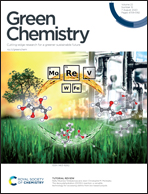Oxidized graphitic carbon nitride as a sustainable metal-free catalyst for hydrogen transfer reactions under mild conditions†
Abstract
The development of green and sustainable transfer hydrogenation protocols without the use of expensive noble metals and toxic solvents is a challenging task. Herein, a highly stable, low-cost, metal-free heterogeneous catalyst, oxidized graphitic carbon nitride (O-GCN), has been developed, which exhibits efficient catalytic hydrogen transfer reactions of carbonyl compounds to corresponding alcohols under mild reaction conditions. The heterogeneous catalyst was synthesized by the chemical oxidation of graphitic carbon nitride (GCN) nanosheets, which results in the generation of carboxyl, hydroxyl and ketone groups over the GCN surface. These hydrophilic groups functionalized on the surface of O-GCN nanosheets act as catalytically active sites for the hydrogen transfer reactions of carbonyl compounds. A wide range of substrates was investigated for the hydrogen transfer reactions using 2-propanol both as a hydrogen donor and a solvent. The O-GCN nanosheets resulted in high yields and high turnover numbers (TON) demonstrating the versatile catalytic potential of the as-synthesized catalyst. The detailed optimization of the reaction parameters (temperature, time and catalyst amount) was performed, in addition to the calculation of green metric parameters. Moreover, the catalyst could be easily recovered and was used for five runs without any significant loss in catalytic activity. This study provides a green, sustainable, attractive, and useful methodology for the hydrogen transfer reactions of a wide range of carbonyl compounds.



 Please wait while we load your content...
Please wait while we load your content...